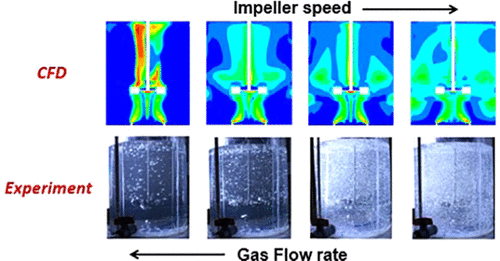当前位置:
X-MOL 学术
›
ACS Eng. Au
›
论文详情
Our official English website, www.x-mol.net, welcomes your feedback! (Note: you will need to create a separate account there.)
Comparison of Different Impellers for Gas Dispersion in Power-Law Fluids
ACS Engineering Au Pub Date : 2021-11-15 , DOI: 10.1021/acsengineeringau.1c00020 Shruti P. Hinge 1 , Ravi Kumar 1 , Ashwin W. Patwardhan 1
ACS Engineering Au Pub Date : 2021-11-15 , DOI: 10.1021/acsengineeringau.1c00020 Shruti P. Hinge 1 , Ravi Kumar 1 , Ashwin W. Patwardhan 1
Affiliation

|
The 3D multiphase computational fluid dynamic (CFD) models have been developed for gas–liquid systems in a standard baffled stirred tank reactor (diameter 0.3 m) for non-Newtonian power-law fluids. The standard k-ε model has been used to model the turbulence, and drag has been modeled with the Grace drag model with Brucato modifications. CFD simulations have been carried out for three impellers, namely, the Rushton turbine, pitched blade turbine, and hydrofoil impeller. The effects of impeller design, power input per unit volume of the fluid (P/V) (1200–5200 W/m3), fluid rheology (K = 0–0.1561 Pa·sn, n = 0.687–1.000), and superficial gas velocity (7.1–28.3 mm/s) have been analyzed. The CFD model has been validated with the local distribution of axial, radial, and tangential velocities and overall gas holdup data reported in the literature. The CFD model has been used to predict the regime transition from flooding to loading and complete dispersion. A good agreement was observed for the prediction of regime transition for the Rushton turbine when compared with the experimental data. The average value of absolute error for the prediction of the gas holdup is 20%, which indicates that the developed CFD model can be successfully used to predict the gas holdup and regime transition in stirred tank reactors. Among the impellers studied, the hydrofoil impeller shows the highest gas holdup and uniform gas distribution in the vessel at low power consumption.
中文翻译:

幂律流体中气体分散的不同叶轮的比较
3D 多相计算流体动力学 (CFD) 模型已针对非牛顿幂律流体的标准挡板搅拌釜反应器(直径 0.3 m)中的气液系统开发。标准k- ε 模型已用于模拟湍流,阻力已使用带有 Brucato 修改的 Grace 阻力模型进行模拟。已经对三个叶轮进行了 CFD 模拟,即 Rushton 涡轮机、变桨叶轮机和水翼叶轮。叶轮设计的影响,单位体积流体的功率输入 ( P / V ) (1200–5200 W/m 3 ),流体流变学 ( K = 0–0.1561 Pa·s n , n= 0.687–1.000),并分析了表观气体速度 (7.1–28.3 mm/s)。CFD 模型已通过文献中报道的轴向、径向和切向速度的局部分布以及总体含气量数据进行了验证。CFD 模型已被用于预测从泛滥到加载和完全分散的状态转变。与实验数据相比,Rushton 涡轮机的状态转变预测得到了很好的一致性。含气率预测的绝对误差平均值为 20%,这表明所开发的 CFD 模型可以成功地用于预测搅拌釜反应器中的含气率和状态转变。在研究的叶轮中,
更新日期:2021-11-15
中文翻译:

幂律流体中气体分散的不同叶轮的比较
3D 多相计算流体动力学 (CFD) 模型已针对非牛顿幂律流体的标准挡板搅拌釜反应器(直径 0.3 m)中的气液系统开发。标准k- ε 模型已用于模拟湍流,阻力已使用带有 Brucato 修改的 Grace 阻力模型进行模拟。已经对三个叶轮进行了 CFD 模拟,即 Rushton 涡轮机、变桨叶轮机和水翼叶轮。叶轮设计的影响,单位体积流体的功率输入 ( P / V ) (1200–5200 W/m 3 ),流体流变学 ( K = 0–0.1561 Pa·s n , n= 0.687–1.000),并分析了表观气体速度 (7.1–28.3 mm/s)。CFD 模型已通过文献中报道的轴向、径向和切向速度的局部分布以及总体含气量数据进行了验证。CFD 模型已被用于预测从泛滥到加载和完全分散的状态转变。与实验数据相比,Rushton 涡轮机的状态转变预测得到了很好的一致性。含气率预测的绝对误差平均值为 20%,这表明所开发的 CFD 模型可以成功地用于预测搅拌釜反应器中的含气率和状态转变。在研究的叶轮中,



























 京公网安备 11010802027423号
京公网安备 11010802027423号